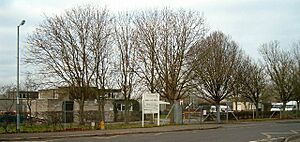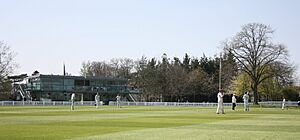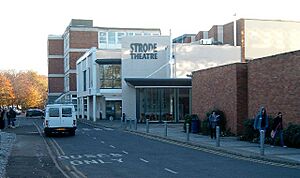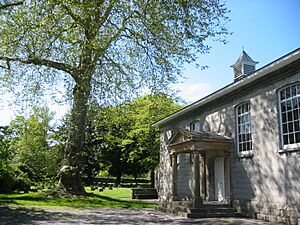Street, Somerset facts for kids
Quick facts for kids Street |
|
|---|---|
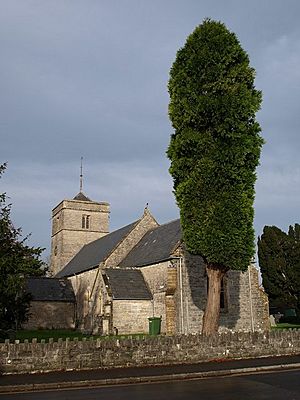 Church of the Holy Trinity, Street |
|
| Population | 11,805 |
| OS grid reference | ST483366 |
| District | |
| Shire county | |
| Region | |
| Country | England |
| Sovereign state | United Kingdom |
| Post town | STREET |
| Postcode district | BA16 |
| Dialling code | 01458 |
| Police | Avon and Somerset |
| Fire | Devon and Somerset |
| Ambulance | South Western |
| EU Parliament | South West England |
| UK Parliament |
|
Street is a large village in Somerset, England. It's a "civil parish," which means it has its own local government. In 2021, about 12,709 people lived here.
Street is located on a dry area within the Somerset Levels, which are low, flat lands. It sits at the end of the Polden Hills, about 2 kilometers (1.2 miles) southwest of Glastonbury. People have lived here since Roman times.
A big part of Street's history is linked to Glastonbury Abbey. In the 12th century, a special road called a causeway was built from Glastonbury to Street. This was used to bring local "Blue Lias" stone to help rebuild the Abbey.
The Religious Society of Friends, also known as Quakers, started a community in Street in the mid-1600s. A Quaker family, the Clarks, began a business making sheepskin rugs and woollen slippers. Later, they started making boots and shoes, and their company, C&J Clark, grew very big. Its main office is still in Street today.
In 1993, some old factory buildings were turned into Clarks Village. This was the first shopping center in the UK built specifically for factory outlet stores. You can learn more about the history of Clarks and how shoes are made at The Shoe Museum in Street.
The Clark family's old home and its land are now part of Millfield School. This is a large, private boarding school. Street also has other schools, including Crispin School and Strode College.
North of Street is the River Brue, which forms the border with Glastonbury. To the south are the Walton and Ivythorn Hills and East Polden Grasslands. These areas are special nature sites called "Sites of Special Scientific Interest" (SSSIs) because of their important plants and animals.
Street also has the Strode Theatre, where you can watch movies, see art, and enjoy live shows. The main church, the Anglican Parish Church of the Holy Trinity, Street, was built in the 14th century. It's considered a very important historic building.
Contents
History of Street
The oldest known name for this area was Lantokay. This name means "the sacred place of Saint Kea," who was an old Celtic saint. The name 'Street' first appeared in old English documents from 725 and 971. It comes from the Old English word straet, which means 'Roman road'.
The center of Street today was once a small village called Lower Leigh. Other areas like Middle Leigh and Overleigh are to the south.
In the 1100s, a causeway was built from Glastonbury to Street. This was to move stone from Street to rebuild Glastonbury Abbey after a big fire in 1184. This causeway is about 90 meters (100 yards) north of an even older Roman road. So, the village was named after the Roman road, not the causeway.

Street was part of an old area called the Whitley Hundred. A "hundred" was a historical division of a county in England.
Blue Lias Stone and Fossils
People started digging for local "blue lias" stone in Street as early as the 1100s. This continued until the late 1800s. Blue lias is a type of rock found in southern England. It's made of layers of limestone and shale. These layers formed between 195 and 200 million years ago, during the late Triassic and early Jurassic periods.
Blue lias stone is thin and has a blue, clay-like look. It's famous for having many fossils, especially ammonites. Many ichthyosaurs, which were ancient marine reptiles, have also been found here. One ichthyosaur fossil is even the symbol for Street. You can see some Street fossils at the Natural History Museum in London.
Early Settlements
An old Iron Age coin was found in the churchyard of the Parish Church. We don't know much about its meaning, but the Dobunni people were known to make coins in this area. Pieces of Roman pottery have also been found and are now in the Museum of Somerset.
Remains of Roman villas (large country houses) exist on the south side of Street. Parts of a Roman road were also found buried between Glastonbury and Street. The parish churchyard is on the first dry land near the River Brue. This suggests it was probably one of the first places people lived. The shape of the churchyard looks like a "llan," which was a sacred area built around the 6th century. "Llan" is a Welsh word that originally meant "an enclosed piece of land," but later came to mean the area around a church.
One story says that St Gildas, a saint, lived at Glastonbury Abbey. He then moved to a spot by the river, where he built a chapel to the Holy Trinity. He is said to have died there. The Parish Church, now called Holy Trinity, was sometimes known as St Gildas' church. Glastonbury Abbey controlled Street until the monasteries were closed down in the 1500s.
Historic Buildings
Sharpham Park is a historic area of about 120 hectares (300 acres) west of Street. It dates back to the Bronze Age. The first mention of it was in 957. In 1191, it was given to the Abbots of Glastonbury. They owned it until the monasteries were closed in 1539. Many famous people were born at Sharpham, including the poet Sir Edward Dyer and the writer Henry Fielding. The house is now a private home.
Ivythorn Manor was a medieval house for monks. It was rebuilt in 1488 for Abbot John Selwood of Glastonbury Abbey. After the monasteries closed, it became a manor house. It was mostly ruined by 1834 but was restored around 1904. It is also a very important historic building.
Local Government
Street has a parish council. This council handles local issues like setting a local tax to cover its costs. It also looks at building plans, works with the police on crime and traffic, and helps maintain local facilities. The parish council also talks with the district council about roads, drainage, footpaths, public transport, and street cleaning. They also care for trees and historic buildings.
Street is part of the Mendip District. This district council handles bigger things like planning permission, building rules, council housing, and waste collection. People in Street elect councillors to the Mendip Council every four years.
Somerset County Council is in charge of the largest and most expensive local services. These include education, social services, libraries, main roads, public transport, police, and fire services.
Street is also part of the Glastonbury and Somerton area for the UK Parliament. This area elects one Member of Parliament (MP). The current MP is Sarah Dyke.
Street is twinned with two towns: Isny im Allgäu in Germany and Notre Dame de Gravenchon in France. This twinning is a friendship agreement between the towns.
Geography and Nature
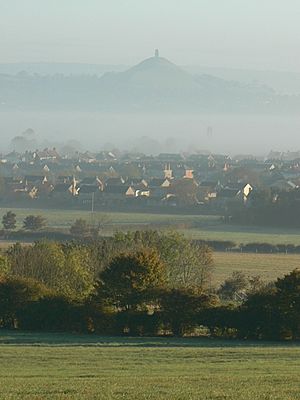
The River Brue forms the northern border of Street with Glastonbury. Long ago, the Brue created a lake south of Glastonbury. Some legends say this lake was home to the Lady of the Lake from the King Arthur stories. Pomparles Bridge, at the west end of this lake, is where Sir Bedivere is said to have thrown the sword Excalibur after King Arthur's last battle. The old bridge was replaced in 1911.
Before the 1200s, the river's path to the sea was blocked. This made it hard for Glastonbury Abbey to move goods. Between 1230 and 1250, a new channel was dug westwards. This helped the river flow better and stopped Glastonbury from flooding. The Brue Valley Living Landscape is a project that helps protect the nature of the Somerset Levels and Moors.
Walton and Ivythorn Hills
The Walton and Ivythorn Hills are south of Street. They are managed by the National Trust. These hills have different natural areas like grassy fields, bushes, and woodlands. These different habitats are perfect for many insects. You can find many kinds of Butterflies, leafhoppers, spiders, and soldier flies here. The great green bush cricket is also found here.
Next to these hills are the East Polden Grasslands. These grasslands have many types of plants, including the rare early gentian. This plant only grows in Britain. This area is also a good home for the large blue butterfly, which has been successfully brought back to the site. You can also find two rare types of grasshoppers and several rare moths, beetles, bees, and ants.
Street Heath
Street Heath is a nature reserve managed by the Somerset Wildlife Trust. It has great examples of habitats that used to be common on the Somerset Levels. These include wet and dry heath, bogs, and wet woodlands. Rare ferns like the marsh fern and royal fern grow here. Old peat workings and ditches have plants like bulrush and yellow flag iris. Many insects have been recorded, including 33 types of butterflies and 200 types of moths. Birds like the willow tit also live in the woodlands.
Merriman Park is named after Nathaniel James Merriman. He was a church leader in Street before moving to South Africa.
Climate
Street has a mild and wet climate, like the rest of South West England. The average yearly temperature is about 10°C (50°F). Temperatures don't change as much as in other parts of the UK because of the nearby sea. July and August are the warmest months, with average high temperatures around 21°C (70°F). In winter, the average low temperatures are around 1°C or 2°C (34°F or 36°F).
Street gets about 700 mm (28 inches) of rain each year. Most of the rain in autumn and winter comes from storms over the Atlantic Ocean. In summer, rain often comes from thunderstorms caused by the sun heating the ground. Snowfall is typical for about 8–15 days a year. The wind is usually strongest from November to March and lightest from June to August. The main wind direction is from the southwest.
C. and J. Clark Ltd
The Religious Society of Friends, or Quakers, became established in Street in the mid-1600s. The Clark family was part of this group. Cyrus Clark started a business making sheepskin rugs. His brother James joined him and began making woollen slippers, and then boots and shoes. Under James's son, William, the business grew a lot. Much of the money they made was used to help their employees with housing and education.
C&J Clark still has its main office in Street. You can see its clock tower and water tower. However, shoes are no longer made there. Instead, in 1993, some old factory buildings were turned into Clarks Village. This was the first shopping center in the UK built specifically for factory outlet stores. Even though some local shop owners were worried at the time, Clarks Village did not cause other shops to close.
The Shoe Museum tells the story of Clarks and how shoes are made. It also shows old advertisements from the 1930s, 1950s, and 1960s.
The Clark family's large house and land are now part of Millfield School. The company also had a small hospital and recovery home on Ivythorn Hill for its employees. In 1931, this building became the first youth hostel in Somerset. It is still used as a youth hostel today.
Transport
In Roman times, Street was near the Fosse Way, an important Roman road. Today, Street is on the A39 road, which goes from Bath to Cornwall. It's also on the A361 road.
Glastonbury and Street railway station was the largest station on the old Somerset and Dorset Joint Railway. It closed in 1966. The closest train stations now are about 9 miles away, in Castle Cary and Bridgwater.
Several bus services run through Street. Route 376 goes to Bristol via Wells every 20 minutes from Monday to Saturday. Berrys Coaches also offers a daily "Superfast" service to and from London.
Education
Street has several primary schools for younger children, including Avalon, Brookside, Hindhayes, and Elmhurst.
Crispin School is the secondary school for students aged 11 to 16 from Street and nearby villages. It has over 1,000 students. In 1997, it became the first "Beacon School" in Somerset, recognized for its excellence. It specializes in Technology and Languages.
The school shares its campus with Strode College. This college provides education for students aged 16 and older. They offer courses like A-levels and BTECs. Strode College also has courses for older students and some university-level programs.
On the edge of the village is Millfield School. This is a private boarding school for about 1,260 students. It was started in 1935 by Boss Meyer. It uses the house and land that originally belonged to the Clark family, who owned the famous shoe company.
Sport and Leisure
Street has a football club called Street F.C. They play their games at a place called The Tannery.
Street has two public swimming pools, one indoors and one outdoors. The indoor pool is part of the Strode complex. The outdoor pool, Greenbank, is open every day from early May to mid-September.
The only movie theater in Street closed in the 1990s and became a nightclub. Now, Strode Theatre is the only place to watch films, see art shows, and enjoy live performances. It opened in 1963 with a performance by the Bournemouth Symphony Orchestra. In 1999, the theater was made bigger with a new lobby, bar, and ticket office. This cost £750,000 and won an award for its design.
The village is also on the route of the Samaritans Way South West, a long-distance walking path.
Religious Sites
The Anglican Parish Church of the Holy Trinity, Street was built in the 14th century. It was greatly repaired in the 1800s. It is considered a very important historic building. The oldest part of the church was built around 1270. The first known priest was John de Hancle in 1304. This church is connected with the Street Mission Church and the church in Walton.
There is also a Baptist church on Glaston Road. The Quaker Friends Meeting House was built in 1850. The United Reformed Church, Street was built on High Street in 1854–55, and Street Methodist Church was built on Leigh Road in 1893.
Notable People
Many interesting people have connections to Street:
- Helen Chamberlain, a TV presenter, was born in Street in 1967.
- Alice Clark, a historian and supporter of women's rights, was born and died in Street. She wrote about women's working lives.
- Edwin Edwards (organist), an organist and composer, was born in Street in 1830.
- John Hinde, a photographer known for his beautiful and nostalgic postcards, was born in Street.
- Clemence Housman, an author and artist, lived in Street with her brother Laurence.
- Laurence Housman, a writer and artist, lived in Street for 35 years until he died in 1959. He was the younger brother of the famous poet A.E. Housman.
- Catherine Impey, who started an anti-racism journal, was born in Street in 1847. She worked with famous African Americans like Frederick Douglass to fight against racism.
- Jaye Jacobs, an actress.
- John X. Merriman was born in Street in 1841. He later moved to South Africa and became the last prime minister of the Cape Colony.
- Henry John "Harry" Patch (1898-2009), the last surviving British soldier from World War I, moved to Street in the 1940s. He ran a plumbing company here until he retired.
Freedom of the Parish
Some people and military groups have been given the "Freedom of the Parish" of Street. This is a special honor.
- WO 1 Matthew Tomlinson received this honor on October 16, 2010.
|
See also
 In Spanish: Street para niños
In Spanish: Street para niños





